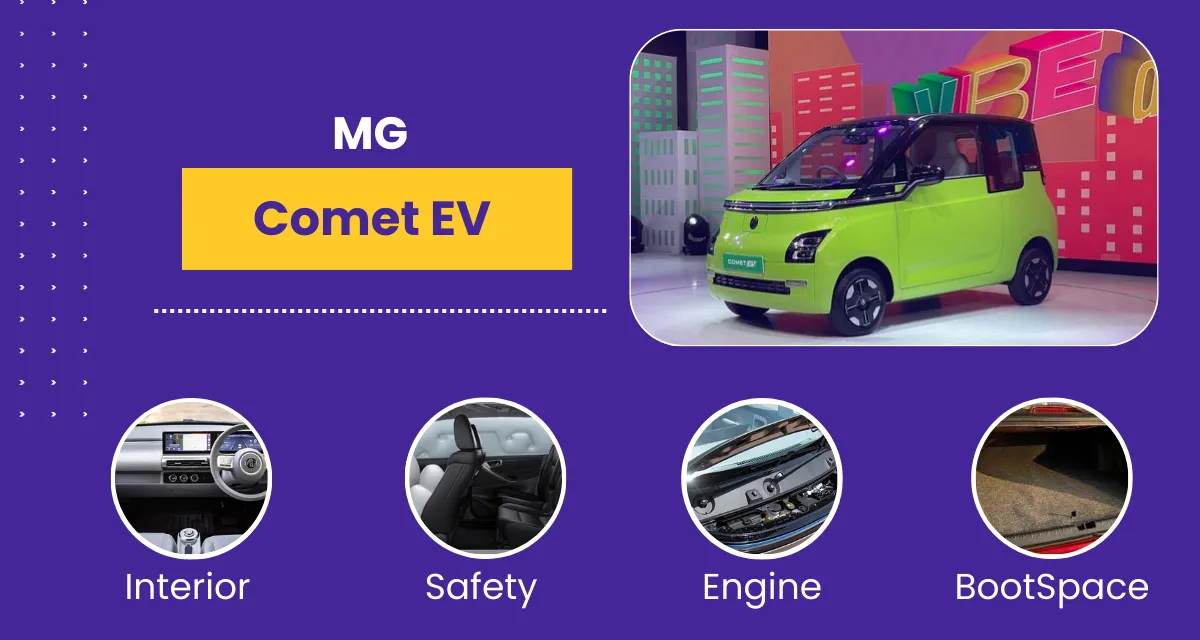

In India, the brand-new MG Comet EV has been introduced at a 7 lakh 98 thousand rupee introductory price. The brand-new electric vehicle competes with the Citroen eC3 and Tata Tiago EV models. It is over 3 lakhs 50 thousand rupees more affordable than the top-end trims of both models and about 80,000 rupees more affordable than the Tiago EV's base variants.
The MG Comet EV has unique features; however, there have been EV cars before this with similar footprints. MG has released this car in the Indian market as an urban mobility solution for the common people commuting around 100 kms a day with the primary motive of traveling easily in day-to-day traffic. This car, according to MG, is easier to navigate and frugal at the same time.
The Comet's design execution is more upscale due to its liberal use of chrome, striking colors, and numerous LEDs, seen in its headlamps, taillamps, wing-mirror indicators, and distinctive light bars at the front and rear. The high-quality components inside each projector unit make the lighting appear especially upscale. Even the MG logo is illuminated. Another daring break from tradition is that it only has two doors, and the back seat's non-openable "porthole" window adds to its design flourish.
The MG Comet EV is well-equipped with contemporary creature comforts, including an air purifier, a 10.25-inch touchscreen with wireless Android Auto and Apple CarPlay, and connected car technology. It has a 17.3 kWh battery with a range of 230 km and can be fully charged in just 5 hours. MG says the Comet EV only costs 519 rupees to travel 1000 kilometers.
One thing that the car surely does is grab eyeballs on Indian roads with its uniqueness. Moreover, even though the car is small in size, it feels spacious on the inside. The main USP of the car is its ease of driving. The MG Comet has a claimed range of 230 kilometers (km) on the MIDC cycle thanks to a modestly sized Tata Autocomp 17.3kWh prismatic cell lithium-ion battery. A brief, city-focused drive revealed that it held onto its charge well and, extrapolated, worked out to have a range of nearly 170 kilometers. Regarding charging, it is stated to go from 0% to 80% in 5 hours and from 0% to 100% in 7 hours, which makes sense given that all EV batteries slow down their charge rate for the final 20%.
The suspension has especially been tuned according to the needs of the Indian roads making even the hard roads feel soft and comfortable. Even with more passengers on board, the car still manages to feel light and performs in the same manner. One thing that can be noticed is the sound of the battery motor, which one can deal with, given the quality of other features.
Its dimensions are 2.9m long, 1.5m wide, and 1.6m tall, making it the smallest car in India. Wheelbase is 2,010mm, and its 12-inch wheels are pushed out to corners. No DC fast charger would have increased the price of a car that does not need it. If customers request it, the brand may consider adding it to future models.
The Comet's perceived quality, which is high for what might otherwise be mistaken for a low-cost vehicle from the outside, has the potential to be its biggest selling point. The dash and doors have soft-touch material, and the plastic is excellent throughout. It is well put together with few gaps or sharp edges. The roof liner is made of high-quality woven material, and even the color combination of glossy white and light gray gives it a cool, modern vibe, even if it is prone to stains. The steering wheel controls, reminiscent of the Apple iPod's click-wheel 22 years ago, reflect the tech theme.
It has some decent features, a leatherette-wrapped steering wheel and keyless entry and start. The car can even be unlocked using a smartphone. However, the Comet lacks features like automatic climate control, automatic headlamps, and wireless charging that would have complemented its upwardly urban appeal. The two independent 10.25-inch color screens for instrumentation and entertainment, however, are the main topic of conversation. Good touchscreen sensitivity, a tidy user interface, and cool features like smartphone-like customizable home screen widgets for most of its apps are all present. The instrument screen could have benefited from larger graphics that would have been simpler to read while moving, even though SOC, range and even voltage data are quite informative. The Comet icon in the center is cool but takes up too much screen space and alludes to ADAS features that the Indian car lacks. It also accurately illuminates when you use the lights, indicators, brakes, or open the doors.
The steering is nice and light because it isn't weighed down by driveshafts, making it easy to maneuver around town. Its 8.4-meter turning radius is due more to its diminutive size than to the speed of the wheels turning. It's a good thing that the steering isn't overly quick or sharp because the vehicle's short length, top-heavy height, and small wheels make sudden changes in direction difficult.
In terms of practicality and utility, it is something that one can work with; there is no dedicated place for keeping phones or other necessities; however, with some small little hacks, it is manageable. The door pockets have umpteen spaces and might act as substitute storage areas. One of the major disadvantages of the car is that there is absolutely no boot space; all that one can manage to fit are a few shopping bags. Even so, it ticks many boxes, acts as an urban mobility solution, and is extremely economical.
It's now time for the contest!
Tell us the name of MG’s connected car tech and win a prize. Watch the Mg COMET EV First Drive Review video and answer the question in the YouTube comment section. The person with the maximum number of correct responses throughout the week wins a prize.
download the Park+! app